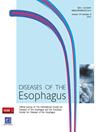746. ESOPHAGECTOMY, WITH CHOLECYSTECTOMY HAS A HIGH INCIDENCE OF REFLUX ESOPHAGITIS AND GASTRIC TUBE ULCER
IF 2.3
3区 医学
Q3 GASTROENTEROLOGY & HEPATOLOGY
引用次数: 0
Abstract
The surgical methods for thoracic esophageal cancer was subtotal esophagectomy, with gastric pull up via retrosternal route, and cervical anastomosis. However, some cases were complicated by acute cholecystitis in the early postoperative period, and cholecystectomy was performed intraoperatively to prevent postoperative cholecystitis in some cases. The disruption of normal anti-reflux mechanisms including the lower esophageal sphincter, angle of His, and diaphragmatic muscle and the denervation of the vagus nerve are generally thought to be the main factors that interfere with gastric motor function. Furthermore, the pressure difference between thoracic (negative) and abdominal cavity (positive) is another factor that promotes reflux across the anastomosis. Due to these factors, postoperative reflux esophagitis is frequently experienced. Furthermore, after cholecystectomy, due to loss of gallbladder reservoir function after cholecystectomy and decrease in antroduodenal motility, bile is not excreted by food intermittently but continuously, resulting in duodenogastric reflux. We investigated postoperative reflux esophagitis and gastric tube ulcers in cases with and without intraoperative cholecystectomy for the past three years. We investigated cholecystectomy with esophagectomy (n=65) and non-cholecystectomy with esophagectomy (n=101) in 166 cases of radical surgery for esophageal cancer in which 2-3 regions had been dissected in the past 3 years. As shown in Fig. 1, there are no differences in location, TNM, gender, and PPI administration .reflux esophagitis of the cervical esophagus is A:0 B:2 (3%), C:5 (8%), D:3 (5%) for chole(+), A:2 (2%), B:2 (2%), C:2 (2%), and D:2 (2%) for chole(-). Gastritis was Chole(+) superficial gastritis 14 (21%), metaplasia 4 (6%), chole(-) superficial gastritis 25 (25%), metaplasia 3 (2%). However, gastric tube ulcers occurred in 5 cases (7%) of Chole(+) and 1 case of perforation, while only 1 case (1%) of gastric tube ulcers occurred in Chole(-).. (Conclusion) Esophagectomy, gastric pull up with cholecystectomy has a high incidence of reflux esophagitis in the neck and can also cause ulcers in the gastric tube. Therefore, care should be taken in postoperative follow-up.746.食管切除术和胆囊切除术导致反流性食管炎和胃管溃疡的发生率很高
胸段食管癌的手术方法是食管次全切除术,经胸骨后途径将胃拉起,并进行颈部吻合术。但有些病例在术后早期并发急性胆囊炎,为防止术后胆囊炎,有些病例在术中进行了胆囊切除术。一般认为,正常的抗反流机制(包括下食管括约肌、His 角和膈肌等)被破坏以及迷走神经去神经化是干扰胃运动功能的主要因素。此外,胸腔(负压)和腹腔(正压)之间的压力差也是促进吻合口反流的另一个因素。由于这些因素,术后经常出现反流性食管炎。此外,胆囊切除术后,由于胆囊储库功能丧失和十二指肠前蠕动减弱,胆汁不是间歇性而是持续性地被食物排出,从而导致十二指肠胃反流。我们调查了过去三年中行胆囊切除术和未行术中胆囊切除术病例的术后反流性食管炎和胃管溃疡。我们调查了 166 例食管癌根治术病例中的胆囊切除术伴食管切除术(n=65)和非胆囊切除术伴食管切除术(n=101),这些病例在过去 3 年中解剖过 2-3 个区域。如图 1 所示,颈段食管反流性食管炎在部位、TNM、性别和服用 PPI 等方面均无差异,胆囊(+)为 A:0 B:2 (3%)、C:5 (8%)、D:3 (5%),胆囊(-)为 A:2 (2%)、B:2 (2%)、C:2 (2%)、D:2 (2%)。胃炎为胆囊(+)浅表性胃炎 14 例(21%)、化生 4 例(6%),胆囊(-)浅表性胃炎 25 例(25%)、化生 3 例(2%)。然而,胆囊(+)发生胃管溃疡 5 例(7%),穿孔 1 例,而胆囊(-)仅发生胃管溃疡 1 例(1%)。(结论)食管切除术、胆囊切除术的胃牵拉术在颈部发生反流性食管炎的几率很高,也可能导致胃管溃疡。因此,应注意术后随访。
本文章由计算机程序翻译,如有差异,请以英文原文为准。
求助全文
约1分钟内获得全文
求助全文
来源期刊

Diseases of the Esophagus
医学-胃肠肝病学
CiteScore
5.30
自引率
7.70%
发文量
568
审稿时长
6 months
期刊介绍:
Diseases of the Esophagus covers all aspects of the esophagus - etiology, investigation and diagnosis, and both medical and surgical treatment.
 求助内容:
求助内容: 应助结果提醒方式:
应助结果提醒方式:


